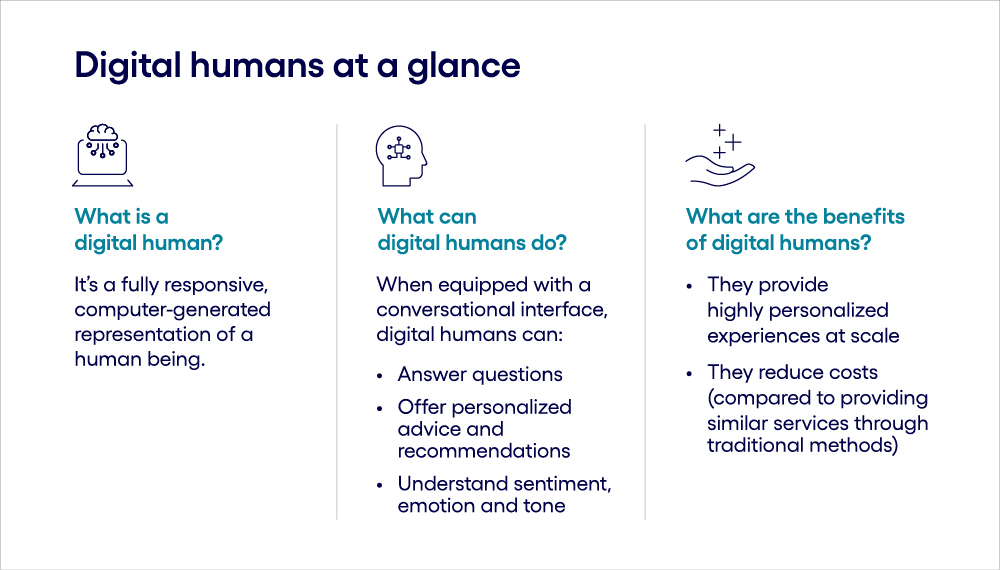March 18, 2024
Digital humans: providing personalized experiences at scale
We offer tips on creating and deploying these avatars without alienating customers.
Meet Iris. She’s the hardest working employee at Dallas Fort Worth Airport, assisting travelers day and night with real-time updates on flight or gate information, personalized dining and shopping recommendations and other special services. A consummate professional, Iris answers every question almost instantly, and even does so with a smile—despite not officially being on the airport’s payroll.
And that’s the twist: Iris isn’t really an employee. In fact, she’s not a person at all. She’s a digital concierge developed by Soul Machines and one of the first examples of digital humans in the market. Introduced in 2022, Iris spends her workdays (24/7 workdays, that is) on voice-activated screens sprinkled throughout the terminal. What sets Iris apart isn't just her tireless work ethic and uncanny ability to produce real-time answers to any and all questions, but her use of cutting-edge technology to provide a deeply human interaction.
While the technology remains in an experimental phase, many organizations are considering how they can use digital humans like Iris to provide fast, accurate, personalized experiences at scale. The solutions certainly hold promise, but implementing them requires careful consideration to ensure they are both useful and used.
Figure 1
Coming to a location near you
Digital humans offer businesses an opportunity to provide personalized experiences at scale. While potential use cases are virtually limitless, the most prominent examples will be in Travel and Hospitality, Retail, and Financial Services—sectors in which companies need to provide differentiated and engaging experiences to a high volume of customers with a wide range of needs.
Sidestepping potential pitfalls
When our team demoed a digital human, co-developed with Soul Machines, at NRF 2024, the retail industry’s biggest trade show, most who interacted with the solution were intrigued by this technology and how they could apply it within their business.
At the same time, it’s important to recognize that digital human technology is truly cutting edge—and for some, that edge may feel too precarious. There are individuals who remain uncomfortable conversing with virtual assistants like Alexa or Siri, let alone with a fully animated counterpart appearing on a screen.
This spectrum of potential reactions underscores the idea that companies must carefully evaluate how they will use this technology and implement solutions in a thoughtful way. While every organization’s journey will be unique, here are three key points any organization should keep in mind as it considers if and how it should explore this technology.
Tip 1: Focus on customers, not capabilities
Businesses must be very clear about who their customer is; that customer’s preferences; and what problems they need to solve. Digital humans will be an appropriate solution in some cases—but may miss the mark entirely in others.
For example, deploying a digital human in a luxury boutique may not be ideal; shoppers in this segment value true human interaction. On the other hand, for retailers that offer a wide range of customized products, a digital human could quickly answer questions related to what materials are available, time required to fulfill an order, and if that particular selection has been made before.
Companies must also consider the digital maturity of their audience. Do their shoppers struggle with self-service checkouts, or do they prefer them? Do their call centers get a large percentage of requests to speak to an agent—or do people gravitate toward automated support channels? The answers to those questions, combined with other customer behavior data, will help a business decide it its customers will find digital humans a convenient asset or an off-putting replacement for real humans.
Tip 2: Select use cases wisely and provide clear, useful information
Digital humans are a new engagement point for most people. For companies that leverage these tools early in the adoption phase, it’s possible to create a new and differentiated experience that will set them apart. However, being at the forefront of any new trend carries risk. Early adopters face heightened pressure to execute flawlessly, as any misstep reflects on not just the technology but the brand itself.
So how do companies ensure their digital human will spark delight and not fright? One key is to start with a clearly defined use case in which the digital human is positioned to deliver a better experience than traditional methods.
For example, if in-store employees are consistently able to answer customer questions about where to find products in a relatively small store, a digital human may not add much. But if visitors are having trouble navigating a larger space, such as a department store, a digital human may enhance their experience. Likewise, for broader venues (think shopping malls, sporting arenas, and public parks), digital humans can provide support economically.
Finally, the key measure of success for this technology will be plain old helpfulness. If a digital human provides clear and useful information, people are more likely to come away with a positive view of the technology. By contrast, if the engagement leaves users grumbling and looking for a “real person,” there are shortcomings within the design and execution of the solution.
Tip 3: Personify the brand and deepen the experience
As digital humans gain popularity, they have the potential to serve as brand ambassadors—and therefore should reflect and reinforce the brand’s image, values and beliefs. That means companies considering them must consider the qualities—physical, emotional, verbal—their digital human should possess.
A related emerging trend in the digital human space is the use of real identities as avatars. For example, Soul Machines’ creation, Digital Mark, is a digital twin of Mark Tuan, a K-Pop sensation. As an avatar of a well-known global artist, the image of Digital Mark would certainly catch the eye of many shoppers when deployed as part of an interactive campaign. This celebrity avatar can also be used as a wayfinding asset in a concert venue or festival location.
As digital humans gain traction, other celebrities and influencers will likely follow in Mark Tuan’s footsteps, lending their identities to this technology. This evolution offers brands the opportunity to maintain partnerships with ambassadors while achieving deeper engagement with shoppers through personalized interactions.
Digital humans and next-level experiences
With digital humans rapidly becoming a reality, leaders must consider how and where this technology could be of use in their enterprise, and how to ensure their investment is met with enthusiasm.
As we navigate this new technology frontier, we welcome brands to boldly imagine their digital future—and the many faces it may have.
Ashok has over 20 years of experience as a Principal Amazon Connect Architect. He has a profound comprehension of cloud contact center protocols, transformation, and solutions with AI/ML capabilities. He is highly skilled in developing and launching innovative contact center offerings for clients in omnichannel, conversational AI and agent assistance.
Shreya Chakraborty leads the marketing and strategy for the contact center practice in the digital experience space. With experience in marketing, consulting and strategy, she is involved in growth initiatives, fostering transformational experiences with partners and cultivating enduring relationships.
Latest posts
Related posts
Get actionable business Insights in your inbox
Sign up for the Cognizant newsletter to gain actionable AI advice and real-world business insights delivered to your inbox every month.


















